Detection of starch content in foodstuffs. Variety of substances. Practical work. "Detection of starch in food"
1. Our inquisitive Parrot made a crossword puzzle for you. Solve it, and you will be convinced that you know not so little about substances.
Horizontally: 1. The substance that makes up lakes, rivers, seas. 2. A substance found in sweets and chocolates. 3. Substances that taste sour. 4. Grape sugar.
Vertically: 1. A substance that can be used to wash dishes, gargle; it is added to the dough. 2. A substance from which wire and some items of utensils are made. 3. The substance of which the nail is composed. 4. A substance that is abundant in potatoes and jelly. 5. A substance that we always see on the dinner table, but never add to tea.
2. Practical work"We examine products for starch content."
Objective: determine whether there is starch in the studied products.
Equipment: products issued by the teacher; diluted tincture of iodine, pipette.
Working process:
1) Conduct experiments: using a pipette, apply a drop of tincture of iodine to each of the products under study.
2) As you work, fill in the table.
Abdrashitova Lyubov Nikolaevna
MKOU secondary school №7 Chelyabinsk region Asha st. 40 years of Victory, 10.
Subject: "A variety of substances. Practical work "Detection of starch in food products".
Lesson type: lesson learning new.
Type of lesson : lesson-study.
Purpose: To introduce substances and their properties; introduce a new section of the textbook;
Develop memory, attention, the ability to find answers to questions using a textbook; to cultivate a culture of communication with peers during the lesson;
Goals aimed at achieving the results of activities:
Metasubject:
R:- formulation learning task lesson, based on the analysis of the textbook material in joint activities, understanding it, planning, together with the teacher, activities to study the topic of the lesson, evaluating their work in the lesson;
P:- develop readiness to accept and solve a learning problem; analysis of scientific and educational text,
highlighting the main idea in it; Learn to describe observations and set up experiments; build reasoning or proof of their point of view on the topic of the lesson in accordance with age norms; work in a group during experiments;
TO:- learns to answer questions from the textbook; discussion in a pair of answers to the questions of the textbook;
Proof of your point of view; To learn to describe the studied substances, to prove assumptions with reason; draw conclusions.
Lesson equipment: projector and presentation for the lesson, assignments for group work, textbook Grade 3 " The world» Pleshakov A.A., workbook for the textbook, task cards; iodine solution,
pipettes, food (potato, apple);
for practical work: salt, sugar, starch.
CD - Disc "World around".
Lesson stage
Purpose of the stage
Teacher activity
Student activities
The result of the formation of UUD
1. Organizational moment.
Positive attitude of students to the lesson.
Everything is in place
Is everything in order?
Pen, book and notebook.
The bell has already rung
We start the lesson.
Greeting teacher and students.
2.Updating knowledge, checking homework.
1.Individual tasks:
1) Underline with a red pencil solid substances, blue - liquid substances, green - gaseous.
Carbon dioxide, salt, iron, copper, hydrogen, silver milk, water.
2) Give examples of natural, artificial and celestial bodies.
Listen to the story of the great Russian scientist M.V. Lomonosov.
2. Frontal survey.
What is a body? What are the bodies?
What are substances made of?
Doing work on cards.
Performing work on the card and the oral response of students.
Students give examples.
Improve the ability to classify substances according to their characteristic features.
Narrative and description of the bodies
Develop interest in scientific and educational article.
3. Self-determination to activity.
Write the term on the board.
Solve riddles.
I thought it was chalk, because it is white,
And he took it in his hands, he ran with water.
Not a forest, but noisy.
Not a horse, but running.
What is one word for these concepts?
What are we going to talk about in class today?
Absolutely, true about substances and learn how to describe them.
The science that studies substances is called chemistry.
Snow
Water.
Substances.
Formulated-
learning task of the lesson.
4. Work on the topic of the lesson.
Practical work.
(group work)
Textbook work
Conversation "Variety of substances".
Plan their activities; learn to describe the studied substances;
Conduct experiments and analyze research results,
writing them down in a workbook;
build evidence of their point of view;
Reading and answering questions from the textbook
Teacher's story.
The first substance we will consider is salt.
What do you know about salt?
Table salt is one of the mineral salts found in nature. Some of them are mined by people and used as fertilizer for plants.
The most important property of table salt for a person is that it tastes salty.
Therefore, it is used for salting food.
In nature, table salt is found not only underground.
Much of it is contained in sea water, as well as in the water of salt lakes. It is also in the soil.
And now let's listen to Danil's message about table salt. The next ingredient is sugar.
What do you know about sugar? Name its main property.
In India, kids today, like many years ago, love to collect sugar cane. Its stalk is extremely sweet and for gourmets it's the same as our candies.
In India, almost every family plants a sugar cable on their plot.
Tnik. And in Cuba, peasants are planting sweet cane. And in other hot countries too. The time will come to harvest, the peasants with a long knife - a machete - cut reed after reed - and into the cauldron.
Boiled on fire - white sweet crystals are obtained. The Indians call them "sakar", and we call them the similar word "sugar". True, we do not boil sugar from sugar cane, which does not grow in our area, but from sugar beets. Do not think that this is the same beet, about which the riddle says: “Green above, red below, grown into the ground.” No, this is another beet: not red and white very sweet. Our great-grandfathers used to cut it into slices and drink tea with it. Like us with white sugar cubes. And instead of sugar in those days they ate honey,
They drank the sweet juice of maple, linden.
They even made marshmallows from these juices.
They sold sugar not in a shop, but in a pharmacy, along with all sorts of rare drugs. It was taken as a medicine, it was very expensive.
To have a lot of cane sugar, you need a lot of cane. It is not for nothing that our friends, the Cubans, plant entire reed groves on their island. Well, to have a lot of beet sugar, you need a lot of sugar beet.
Read the second paragraph of the text in the textbook on p. 42
What other sweet substances are found in nature?
Where is glucose found in nature?
Starch.
This is White powder. It is usually used when brewing jelly. It is one of the most important nutrients necessary for a person. It is found in many foods plant origin. Scientists-
Chemists have suggested how to find out if there is
Starch is one product or another.
To do this, you need a tincture of iodine diluted with water. If you drop it on a product that contains starch, the tincture will change color to blue-violet.
With diluted tincture
Yoda, determine if there is starch in you -
Products given to you.
Record the results of the study
And draw in your workbook.
Tell us about your results.
Read the text on pages 43-44 in your textbook.
What is the name of large group substances found in the kitchen?
What foods contain acids?
Name the main property of acids.
What acids do you know?
Can any acid be tested?
Why can't this be done?
Consider table salt.
Student's presentation.
It has a sweet taste.
Student presentation from the report
house.
Glucose.
in various parts of plants. It is especially abundant in grapes and grape juice.
Children do practical work and fill out the table in the workbook from 18. They talk about the results.
acids
Lemon, apple, sorrel, sour milk contain lactic acid.
Acid caustic acids. They corrode human skin.
They plan their activities; the ability to negotiate joint actions.
Search necessary information in the textbook, the ability to navigate in the educational book; self-directed and purposeful
-th choice of book
Physical education
nootka
We stomp our feet
We clap our hands
We nod our heads.
We lower our hands
We circle then.
Perform actions on text.
Consolidation of the studied material
Completing tasks in a workbook
№1 (s16).
- Read the task. Find in the textbook part of the text about table salt.
Name the main property of salt.
Where is salt found?
Where is table salt found?
Write it down in a table.
Salty to taste.
In nature, underground, in the form of a stone.
Answers to questions based on the informative text of the textbook.
Reflection.
Summing up the lesson.
Group work.
The game "Define by touch"
We play the game.
Read the first task in the textbook on p.44.
Make up a description of the substance in the form of a riddle and guess it to the class.
Read the second task on p44.
Execute it.
A game
Try to feel sugar, salt, starch.
Is it possible to do the same by tasting the substance?
So, the substances are very diverse.
What substances do we encounter every day?
Name the main properties of sugar, table salt, starch, acid.
What new did you learn at the lesson?
Well done, the lesson is over.
Compose and guess
riddles
play
An unknown substance should not be tasted as it may be poisonous.
Distribution of responsibilities, drawing up a plan of joint action
Finding the information you need
With the help of a book. manifestation
interest in the cognitive text.
Annotation Project work on the topic "Determination of starch in food products" was carried out using information sources: additional literature and the Internet. The project was created for those who want to learn more about the composition of food (tomato paste), learn about the importance of starch in food. Relevance "A person is born healthy, all diseases enter his body with food through the mouth." Hippocrates Modern man He buys 90% of food products in stores, not paying attention to the composition of the purchased products, which contain food additives that are not always beneficial for human health.
Hypothesis Purpose of work If starch is not specified in the composition of the product, then it should not be found in tomato products. Search for starch in tomato paste using iodine; Determine which tomato pastes contain starch; Make a conclusion on the work done; Tasks Collect and process information; Choose methods for practical study of the topic; Conduct pilot studies; Present the results of the project; Prepare the project for defense and presentation;

Food additives Food additives are used in food products: preservatives, flavors, stabilizers, thickeners. Starch is used as a thickener for making tomato paste, yogurt and other foods. Starch can be found in foods at home, using tincture of iodine.
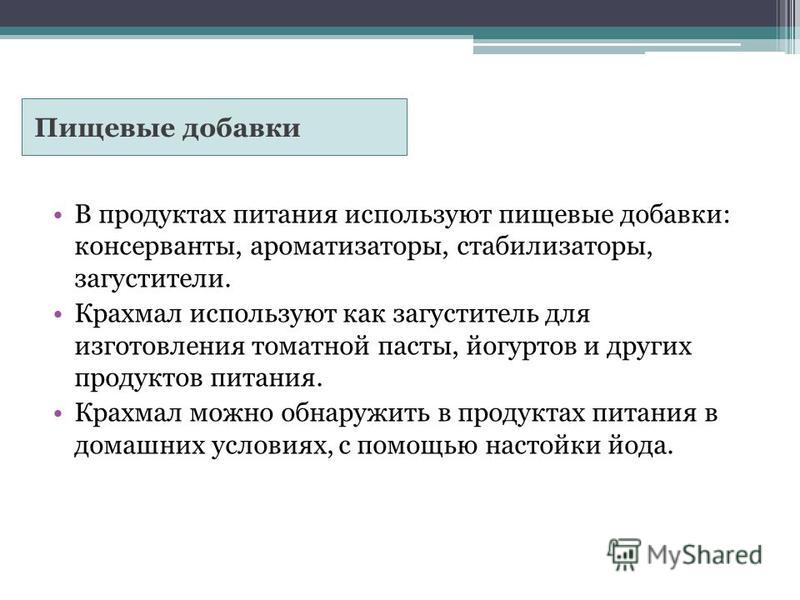
The main part Starch is a natural polymer, the molecules of which consist of individual C 6 H 10 O 5 units. Starch is a white powder, insoluble in cold water. AT hot water it swells and forms a paste. It has been experimentally proven that chemical formula starch (C 6 H 10 O 5) n, where n reaches several thousand.
![]()


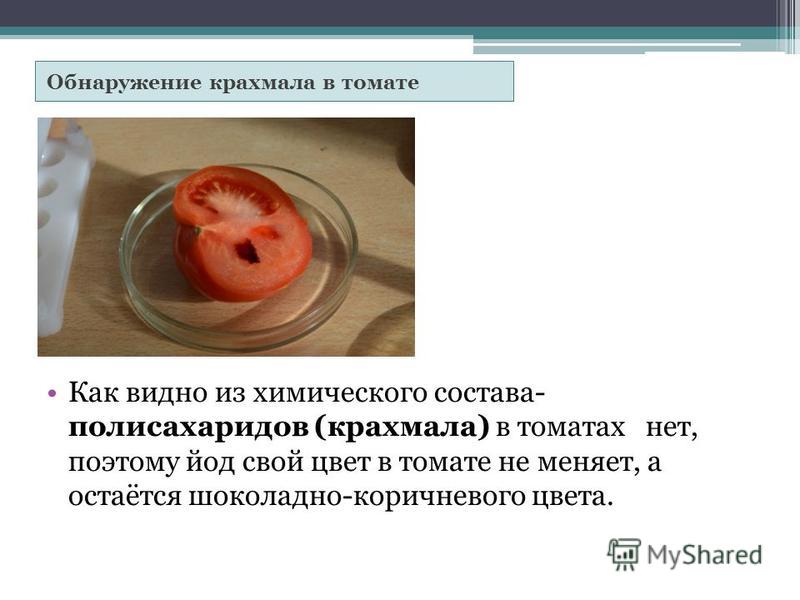
Characteristics of tomato paste High-quality tomato paste should not contain anything but tomatoes, it should have a thick consistency, it should not have dark brown or white inclusions. To protect consumers from low-quality products, GOST 3343–89 was adopted. According to this GOST, tomato paste is a product with a solids content of at least 25% (from 25% to 40%). According to the same GOST, the content of E124 dye and starch in tomato paste is not allowed. Salts - no more than 1.5%. For the experiment, 4 types of tomato paste were purchased:
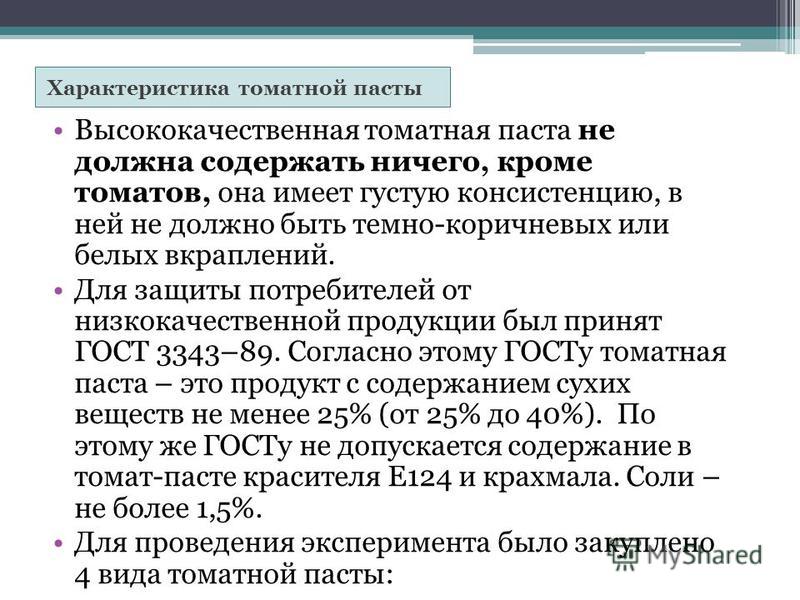


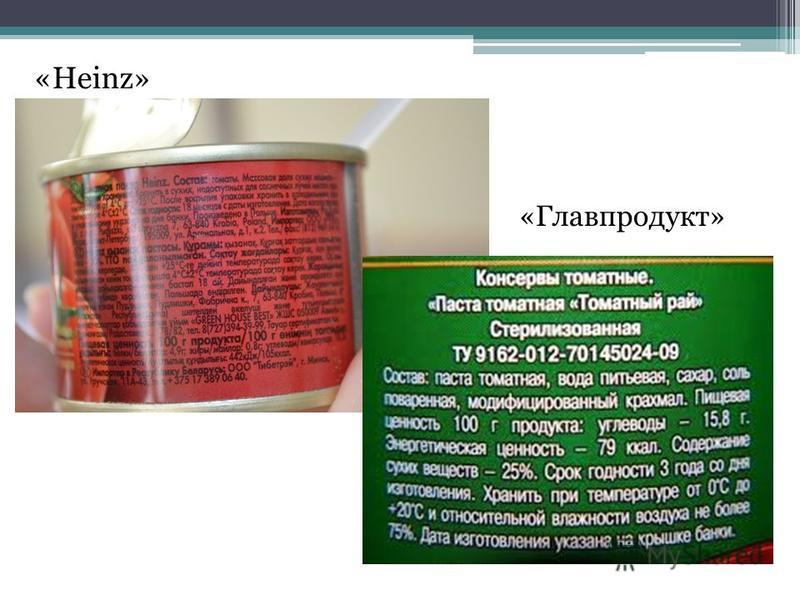

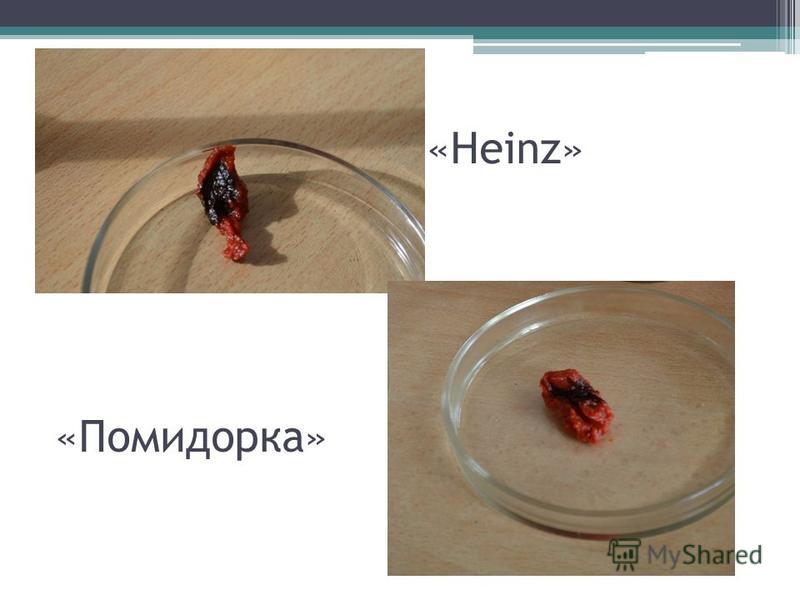
In sample number 4 (“Glavproduct”), there is a similarity between the reaction of iodine and starch paste. Therefore, "Glavprodukt" contains starch, and this product should not be used for food purposes. (Because according to GOST, starch should not be part of tomato paste).
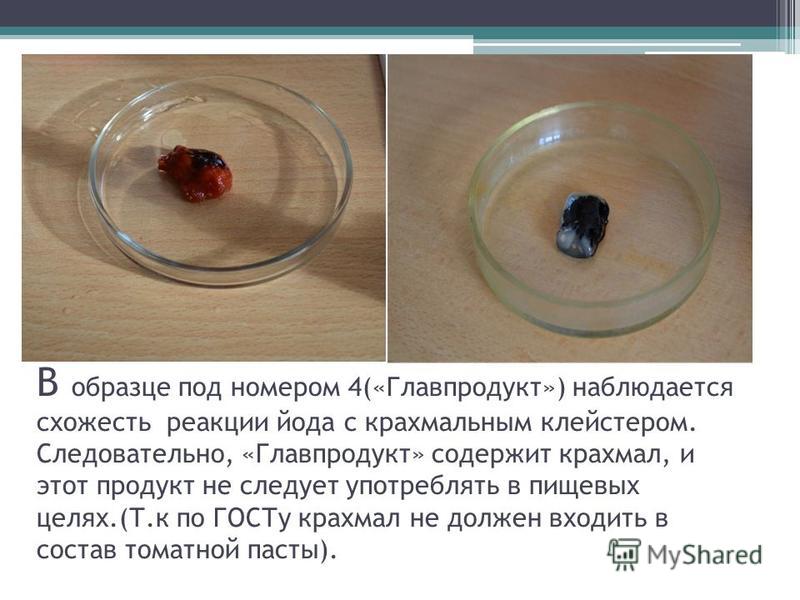

Conclusions There should be no starch in natural tomato products. I was pleased with the result - starch was observed only in the products in which it was declared (in Glavprodukt tomato paste). At home, starch can be detected using iodine tincture, which is in every first aid kit. From what has been done design work it follows that the manufacturers of the product do not deceive buyers. The composition of the declared tomato paste corresponds to the results of the experiment, but according to GOSTs, nothing but tomatoes should be in tomato products. Of the 4 samples of tomato paste offered to us, in two samples, in addition to tomatoes, there is starch indicated on the label and preservative E-211, according to GOSTs, they should not be in tomato paste. You can recommend buying tomato paste "Tomato" and "Heinz".

Helpful Hints When buying food, you need to look at the composition of the purchased products. Try to avoid in the composition of products: preservatives and taste stimulants. Look at appearance products. For cooking, tomato paste can be replaced with tomatoes.

